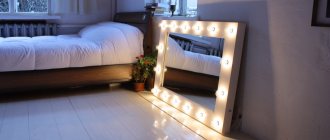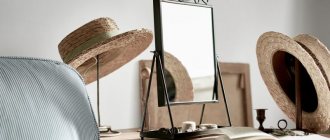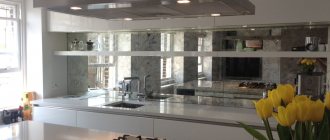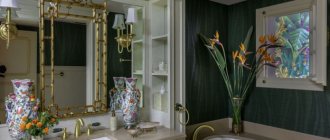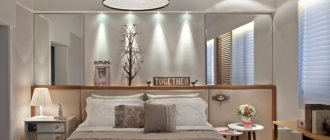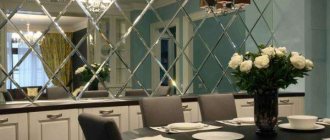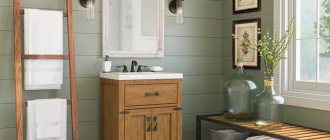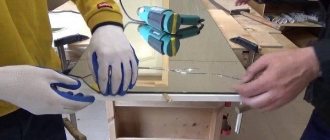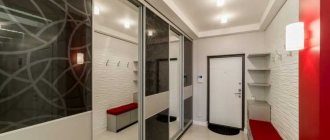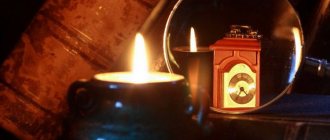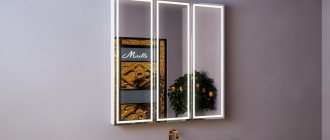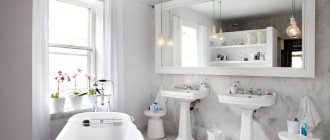Mirrors in the modern world are an integral part of any interior. If in ancient times a mirror had only a functional meaning, today with the help of this item original and extremely effective interiors are created. A beveled mirror will help to completely transform the standard decoration of a room and add some zest. This mirror looks very noble and has an unusual design.
Floor-standing beveled mirror in a classic style
Faceted decorative mirror
What it is?
The name “facet” has French roots and translates as “faceted plane.” Bevel is a method of processing a chamfer (another name for an edge) of mirrors or glass, which allows you to obtain a beveled edge on the front side of interior products. To do this, the edge of the mirror (or glass) is cut at an angle of 45 degrees and the result is an unusual design. In this case, the width of the bevel is most often no more than 6 cm.
Faceted mirror in the living room
Faceted mirror in the kitchen
Bevel cutting gives the mirrors originality and a certain solemnity. Rays of light hitting the mirror surfaces are refracted and spread around the room at different angles, like the sparkle of a diamond.
Insert from a beveled mirror on a wardrobe
Faceted mirror with multiple edges
In addition to their unusual design, mirrors processed in this way look very voluminous and fit well into almost any interior.
The use of this technology helps glassmakers create real masterpieces. The technique has actually been around for a long time. If previously only the skilled hands of craftsmen were used to create such mirrors, today high-tech equipment is used for this. Modern machines allow you to accurately cut an edge from a mirror at the required angle, while simultaneously polishing the cut surface.
Decorative panel made of beveled mirror
Faceted mirror on the ceiling
There are several ways to process mirror panels:
- Straight-line processing - the cut is carried out in a straight line, where the processing width varies from 5 to 50 mm. The minimum size of the product can be from 5x5 cm.
- Curvilinear processing - this method allows the mirror size to range from 11-18 cm, while the parameters of the beveled cut are 5-50 mm.
- Double bevelling - this method allows you to process the mirror on both sides, making the product more elegant, which allows you to give the interior additional sophistication. The refraction of light on a double-sided beveled mirror is more impressive.
- Artistic bevelling is the most sophisticated processing method. The use of multi-colored mirrors in metal frames helps to create unique patterns, as a result of which the interior product resembles a real work of art. For example, with such bevelling you can create bright panels or voluminous stained glass windows. You can use the technology even on a small mirror.
- Facet engraving - technology allows you to turn an ordinary mirror into an expensive decorative element of the interior. In essence, this is an author's painting on a mirror surface.
Faceted mirror in the hallway interior
Faceted mirrors in the hallway
Regardless of the chosen processing method, the bevel of the mirror can be polished to pure transparency or to a matte state.
Rectangular beveled mirror
About technology
Bevelling as a method of processing glass or mirror canvas arose several centuries ago. It involves grinding the edge of the material at a certain angle, resulting in a chamfer. The word “facet” itself is of French origin and means “chamfer, outer edge.”
By the end of the 20th century, high-precision equipment appeared that made it possible to produce bevels automatically. Now the surface is ground down, smoothed and polished according to the specified profile. The resulting edge angle refracts light in a complex way and creates an interesting lighting effect, for which the bevel on the mirror is valued; What’s nice is that the frame is absolutely safe. Because the edge is ground and polished, it is impossible to cut yourself on it.
The angle and size of the bevel are not set arbitrarily; their magnitude depends on the thickness of the mirror. For a canvas with a thickness of 4-20 mm, the width of the bevel (in the case of straight processing) is 4-30 mm. The dimensions are selected carefully, otherwise the mirror is likely to crack or begin to crumble.
Design in a modern style Source design-homes.ru
Faceted mirror in the interior
Mirrors processed with bevel look multifaceted and can turn the interior into luxurious decoration. Such products are very popular among many designers, as well as connoisseurs of original solutions.
Mirror in a beveled glass frame
Wide beveled mirror
A faceted mirror can be combined with almost any interior style. An exception may be, perhaps, interiors in country or Provence style, in which simplicity and practicality are welcomed. But here you can experiment and add a fresh touch. For example, a straight beveled mirror in a bathroom interior will look quite organic. In other cases, beveled mirrors fit perfectly into any interior, be it classic or hi-tech.
Wardrobe with beveled mirror
Aged beveled mirror
Faceted mirrors in a house or apartment can have different designs. The most popular solutions are:
- A solid mirror wall with beveled processing decorates the room and visually increases the volume of space if the interior is decorated in light colors.
- A panel made from beveled components is a non-standard and at the same time original solution.
- Mirror tiles with beveled processing are most often used in bathroom decor.
- Compositions of beveled mirrors in frames look great and practically never go out of fashion.
- Furniture with a beveled mirror – mainly the doors of bedroom or living room furniture.
Faceted mirror in the bedroom interior
Faceted mirror on the wall of the living room
In homes, you can also find other types of faceted mirrors, which not only decorate the interior, but are also a favorite element of household members. For example, these are shaped products that repeat the silhouette of animals or insects. Faceted mirrors with a concave or curved surface can turn a child's room into a corner of laughter.
Wall-mounted bevel mirror
Advantages and disadvantages of facet coating
It may seem that the processing of the edge serves only the decorative function of the bevel on the mirror; but not everyone realizes that this way increases the safety of the product. When bevelling, special grinding machines are used. They process the sharp edge as precisely and carefully as possible, so that after finishing sanding you will not be able to cut yourself on the edge. The procedure does not affect the appearance or characteristics of the canvas in any way.
Bevelling eliminates small irregularities and chips that are somehow present on the workpieces and can cause cracks. Thus, the process increases the strength of the canvas.
The main reason for cutting is to solve decorative problems. A mirror or glass with a beveled coating invariably attracts the eye with the play of light on its edges and turns into a stylish element of the interior. The only disadvantage of such decoration can be considered the need for careful care using special products.
In the kitchen interior Source st.hzcdn.com
See also: Catalog of companies that specialize in the reconstruction and rebuilding of houses
Panel of mirrors
Separately, it is worth highlighting the panel of mirrors, which looks like an artistic composition. To create such a spectacular element, mirror tiles of various sizes are used, with sides beveled at a certain angle. Using tiles, you can simulate any desired configuration and thereby give the interior the necessary atmosphere.
Coffee table made of beveled mirror
Faceted mirror in the bathroom
The faceted mirror panel is particularly beautiful and elegant. This element enhances the decoration of the room and can serve as a stylish highlight of the interior. The decorative product has a number of advantages:
- Originality - an interior element helps to visually expand the space and increase the illumination of the room. At the same time, the bevel emphasizes the edges between the tiles, thereby embodying the effect of a crystal wall.
- Variety - mirror tiles can have different sizes, shapes (square, triangle or hexagon) and color, where products in gray or silver shades look very sophisticated. A panel made of bright multi-colored mirrors looks especially chic.
- Versatility - a decorative item looks good in any size. Using the product you can decorate walls, niches, bedside areas, window slopes, columns and other areas of the room. Particularly daring individuals can even use the product to decorate the ceiling.
- Practicality - faceted panels have an advantage over a solid mirror sheet: if a separate part of the product is damaged, only one element will need to be replaced.
Ceramic tiles can also be used in combination with mirror components. This combination allows you to realize incredible compositions that are not repeated anywhere else.
Wall of beveled mirror in bathroom decor
Venetian beveled mirror
Types of facet
The end of the mirror surface is cut in two ways:
- One-sided (simple) bevel. The face is obtained after performing a single cut; Such mirrors are widespread due to their low cost.
- Bilateral. The chamfer is removed from the front and back parts of the product, increasing the shine of the edges.
The following options are distinguished by form:
- Double, triple bevel. The chamfer is removed several times, with each subsequent bevel narrower than the previous one. Due to this complication, light hitting the surface is refracted more times. Refracted rays increase the shine of the facets to a “diamond”, enhancing the beauty of the play of light and color.
- Straightforward. It is made on canvas in the shape of a square, rectangle or any other shape that does not have smooth lines.
- Curvilinear. Beveled edges turn out to be curved if a round or oval product is processed, as well as a product with a decorative shape (for example, in the shape of a flower).
Decor around the headboard Source ksvmebel.ru
See also: Catalog of projects of two-story houses made of vulture panels
How to use it correctly?
It is very important to place a beveled mirror in the room correctly, otherwise, instead of an elegant design, you can get the opposite effect. To do this, you should follow the designers' recommendations:
- To fill a dark room with additional light, a decorative element must be placed opposite the window.
- You should not place the mirror in front of dark things. When reflected, they will make the room even darker.
- It is not recommended to use a reflective wall opposite the bed. According to psychology, such an arrangement can disrupt restful sleep.
- It is worth taking care of safety and not placing a beveled mirror in an inappropriate place. For example, such a mirror should not be placed in a child’s room if the child is still of an unconscious age.
Vintage beveled mirror
By correctly placing beveled mirror products, you can undoubtedly create a luxurious interior with a pleasant atmosphere. This solution will help to realize unusual design ideas and embody illusions in the interior.
Faceted mirror panel
